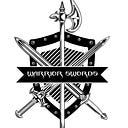Unveiling the Art and History of Fuchi-Gashira
The katana, Japan’s legendary curved sword, embodies both history and craftsmanship. But beyond the captivating blade lies a handle (tsuka) adorned with intricate details. This post delves into the fuchi-gashira, a duo of metal fittings that grace the katana’s handle.
Unveiling the Fuchi-Gashira
More than mere decoration, the fuchi-gashira is a vital pairing on a katana’s handle, serving both practical and aesthetic purposes. It exemplifies the exceptional skill found in Japanese swordmaking. Both the kashira and fuchi, adorned with elaborate designs, resemble capped collars.
- Fuchi (Collar): This metal collar sits at the base of the grip, next to the handguard. It reinforces the grip, preventing breakage and ensuring the blade’s secure attachment to the handle. Often crafted from sturdy metals, the fuchi frequently features intricate engravings and designs.
- Kashira (Pommel Cap): The kashira serves as a stylish and secure cap at the handle’s end. It contributes to the sword’s balance, enhancing its usability. Made from strong metals, it usually complements the fuchi’s design, creating a visually cohesive and tightly sealed handle.
Beyond Beauty: Functionality of Fuchi-Gashira
The true value of the fuchi-gashira transcends mere ornamentation. Here’s a glimpse into its practical purposes:
- Strength and Security: The fuchi-gashira bolsters the handle, keeping its components secure and preventing damage during use.
- Balance is Key: A katana’s weight distribution is crucial. The fuchi-gashira plays a part in achieving this balance, ensuring the sword feels comfortable and wields effectively.
A Canvas for Craftsmanship: The Artistic Side of Fuchi-Gashira
The artistic merit of the fuchi-gashira lies in its exquisite metalwork:
A Metalwork Masterpiece:
The fuchi-gashira showcases the exceptional skills of metalworkers. Through engraving, precious metal inlays, and other techniques, they create captivating designs. These fittings transcend mere decoration; they often depict the owner’s social status, family crest, or beliefs through symbolic motifs.
Appreciating Fuchi-Gashira
Take a closer look at the fuchi-gashira to appreciate its intricate designs and sharp lines. Often crafted from materials like gold or shakudo, these fittings frequently feature symbolic motifs. Researching common symbols in Japanese sword art can help you decipher their meanings and gain a deeper understanding of the historical context behind the designs.
Rare Fuchi-Gashira Designs
Rare fuchi-gashira designs are coveted for their unique artistry and historical significance. Some showcase intricate depictions of Japanese mythology, such as dragons and phoenixes, exhibiting masterful engraving and inlay work. Others bear the family crests of renowned samurai clans, symbolizing the owner’s heritage and social standing. Historical examples, particularly those from the Edo period, often display unparalleled craftsmanship and detail, making them highly sought-after by collectors and historians alike. These rare designs offer a fascinating glimpse into the rich cultural and artistic heritage of Japan’s samurai era.
Fuchi-Gashira: A Window into Japanese Culture
The fuchi-gashira is more than just a sword component; it embodies the profound culture and exceptional skill behind Japanese swordmaking. This duo, comprised of the fuchi (metal collar) and the kashira (pommel cap), enhances the katana’s strength and beauty. So, the next time you encounter a katana, take a moment to appreciate the intricate artistry and essential functionality of the fuchi-gashira, reflecting the dedication and tradition poured into these iconic swords.
If you know more about Katana's
